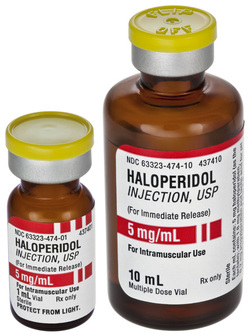Pharmacology definition - Typical Anti Psychotic Agent

Anti psychotic Agent
There are two forms of anti psychotic agent. These are low potency anti psychotic agent and high potency anti psychotic agent.
Low potency anti psychotic agent may include chlorpromazine while high potency anti psychotic agent may include haloperidol
Anti psychotic agent is useful in treating delirium, schizophrenia (positive signs such as hallucinations and delusion), agitation and in some cases for the treatment of Tourette’s syndrome.
Anti psychotic agent will block the dopamine D2 receptor on the postsynaptic region of the limbic area of the brain.
As a result this will reduce the post synaptic neuron response to excitation of dopamine.
The common side effects of anti psychotic agents are associated with the ability of this anti psychotic agent to block H1 histamine receptor, alpha adrenergic receptor and cholinergic receptor.
Patient may suffer from extrapyramidal side effect due to the blockage of the dopamine system. The common symptoms and signs are tardive dyskinesia or involuntary facial oral movement, muscle spasm ( acute dystonia), motor restlessness or akathisia or akinesia due to loss of voluntary movement and amenorrhea as well as galactorrhea due to raised level of prolactin as a result of inhibition of the release of dopamine from pituitary gland.
Patient may also suffer from orthostatic hypotension due to the blockage of alpha adrenergic receptor, sedation due to H1 histamine receptor blocker and finally blockage of cholinergic receptor which lead to blurred vision, dry mouth and urinary retention.
The other complication or side effect of anti psychotic agent may include neuroleptic malignant syndrome. Neuroleptic malignant syndrome may be treated with dopamine agonist or muscle relaxant such as dantrolene. The common symptoms and signs of neuroleptic malignant syndrome are autonomic instability, muscle rigidity, high temperature and change in mental status.
There are two forms of anti psychotic agent. These are low potency anti psychotic agent and high potency anti psychotic agent.
Low potency anti psychotic agent may include chlorpromazine while high potency anti psychotic agent may include haloperidol
Anti psychotic agent is useful in treating delirium, schizophrenia (positive signs such as hallucinations and delusion), agitation and in some cases for the treatment of Tourette’s syndrome.
Anti psychotic agent will block the dopamine D2 receptor on the postsynaptic region of the limbic area of the brain.
As a result this will reduce the post synaptic neuron response to excitation of dopamine.
The common side effects of anti psychotic agents are associated with the ability of this anti psychotic agent to block H1 histamine receptor, alpha adrenergic receptor and cholinergic receptor.
Patient may suffer from extrapyramidal side effect due to the blockage of the dopamine system. The common symptoms and signs are tardive dyskinesia or involuntary facial oral movement, muscle spasm ( acute dystonia), motor restlessness or akathisia or akinesia due to loss of voluntary movement and amenorrhea as well as galactorrhea due to raised level of prolactin as a result of inhibition of the release of dopamine from pituitary gland.
Patient may also suffer from orthostatic hypotension due to the blockage of alpha adrenergic receptor, sedation due to H1 histamine receptor blocker and finally blockage of cholinergic receptor which lead to blurred vision, dry mouth and urinary retention.
The other complication or side effect of anti psychotic agent may include neuroleptic malignant syndrome. Neuroleptic malignant syndrome may be treated with dopamine agonist or muscle relaxant such as dantrolene. The common symptoms and signs of neuroleptic malignant syndrome are autonomic instability, muscle rigidity, high temperature and change in mental status.
